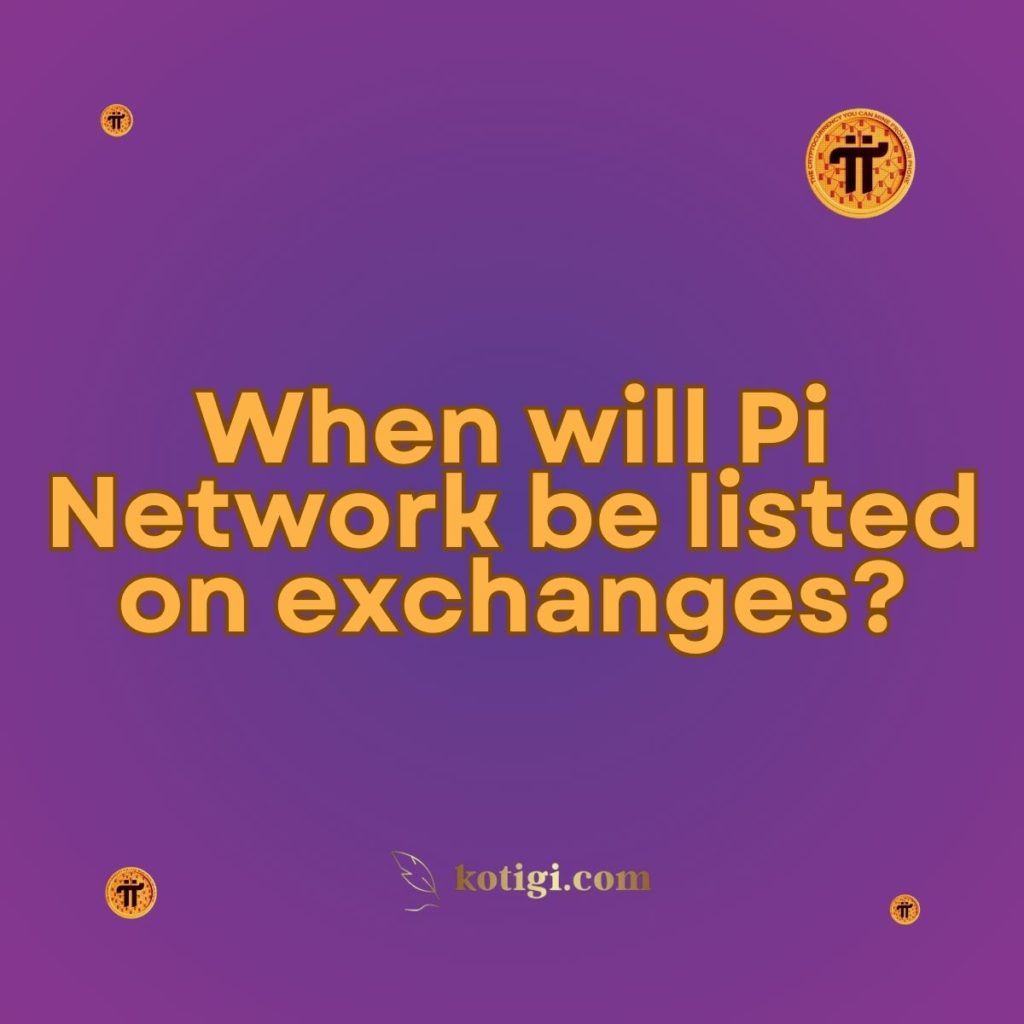
When will Pi Network be listed on exchanges?
The Pi Network is not yet listed on any cryptocurrency exchanges, however the official date frame announced Q1 2025. The listing will depend on the completion of its mainnet launch and regulatory approvals.
Introduction
As the cryptocurrency market continues to evolve, Pi Network has emerged as one of the most intriguing projects. With its user-friendly mobile mining approach, it has attracted millions of users globally, all of whom are eager to know when Pi will be listed on cryptocurrency exchanges. Despite its popularity, Pi has yet to make its debut in the crypto trading world, leaving many wondering when they can start trading the coins they’ve mined. This article explores the key factors that will influence Pi Network’s eventual listing, potential timelines, and what users can expect in the coming months.
Pi Network’s Journey So Far
Since its inception in 2019, Pi Network has grown rapidly, attracting millions of users who “mine” Pi tokens using their smartphones. Unlike other cryptocurrencies that require significant computational power, Pi’s mining model allows anyone with a mobile phone to participate. However, the Pi Network is still in its enclosed mainnet phase, and Pi tokens currently have no real-world value.
The ultimate goal is for Pi to transition from this enclosed phase to an open mainnet, at which point it could be listed on cryptocurrency exchanges. However, several factors need to align before Pi Network can make this move.
Factors Affecting Pi Network’s Listing on Exchanges
Several critical elements determine when Pi Network will be listed on exchanges. These factors are interconnected and will dictate how soon users can trade Pi on platforms like Binance, Coinbase, or other exchanges.
Completion of the Mainnet
One of the primary factors delaying Pi Network’s listing is the completion of its mainnet launch. The mainnet is the final and fully operational version of the Pi blockchain. Currently, Pi is in an enclosed mainnet phase, meaning that Pi transactions cannot be performed outside the Pi Network ecosystem. Before Pi can be listed on exchanges, the network needs to transition to an open mainnet, allowing external wallets and platforms to integrate Pi.
Current Status of the Mainnet
The Pi Network development team has been steadily working on the mainnet, but no official date has been provided for when it will fully open. The developers have indicated that they are taking a cautious approach, focusing on security, scalability, and regulatory compliance before proceeding to the open phase. This careful approach ensures that the network is robust and prepared for the demands of public trading.
What’s Required for the Transition
For Pi Network to successfully transition to an open mainnet, it needs to pass several milestones. These include ensuring that the network is decentralized, securing the blockchain, and performing extensive testing to prevent bugs and vulnerabilities. In addition, the network must achieve consensus among its nodes to confirm that all technical requirements are met.
Regulatory Compliance
Another significant factor that affects Pi Network’s listing on exchanges is regulatory approval. Cryptocurrencies face stringent regulations in various countries, and projects must comply with local laws to be listed on exchanges. Pi Network will need to meet Know Your Customer (KYC) and Anti-Money Laundering (AML) regulations, particularly in markets like the U.S. and Europe.
Legal Challenges in Different Jurisdictions
Different regions have different laws surrounding cryptocurrency. In the U.S., for example, the Securities and Exchange Commission (SEC) has strict guidelines that must be followed. Pi Network will need to ensure that it complies with these regulations to avoid penalties or delays. Similarly, in other countries like China or India, Pi may face regulatory hurdles that could further delay its listing on exchanges.
Importance of KYC Verification
Pi Network has already begun KYC verification for its users, which is a critical step toward regulatory compliance. This process helps the network meet global standards for identifying users, reducing the risk of fraud and illegal activities. However, with millions of users to verify, this is a time-consuming process, which could contribute to delays in Pi’s listing.
Exchange Partnerships
Pi Network will also need to establish partnerships with cryptocurrency exchanges before it can be listed. These exchanges typically perform their own due diligence, reviewing the project’s whitepaper, technology, and community to determine whether it meets their criteria for listing. Partnerships with major exchanges like Binance, Coinbase, or Kraken will be key for Pi’s success in the broader cryptocurrency market.
Potential Exchange Candidates
Several exchanges have expressed interest in listing Pi once it becomes available for trading. These include major platforms such as Binance and Huobi. However, until the network completes its open mainnet and regulatory requirements, no formal partnerships can be finalized.
Listing Criteria on Exchanges
Exchanges typically have strict listing criteria that projects must meet. This includes factors like the size of the user base, the quality of the technology, liquidity, and community support. Given Pi Network’s large user base, it is likely to meet many of these requirements, but this does not guarantee an immediate listing.
What Pi Users Should Expect?
Given these factors, it’s clear that the timeline for Pi Network’s listing is dependent on several milestones being achieved. While there is no official date yet, there are a few things that Pi users can expect moving forward.
A Gradual Rollout
It’s unlikely that Pi will suddenly appear on multiple exchanges overnight. Instead, Pi’s listing is expected to be a gradual process, with smaller, regional exchanges potentially listing the token first. As Pi gains traction and more exchanges see value in listing it, larger platforms may follow suit.
Value of Pi Upon Listing
One of the biggest questions Pi users have is, “What will the price of Pi be when it’s listed?” While it’s impossible to predict the exact value of Pi upon its listing, several factors could influence its price. These include the size of the Pi community, market demand, and the circulating supply of Pi tokens. Early adopters of the network may see significant price fluctuations as the market determines Pi’s true value.
The Role of the Pi Ecosystem
The Pi ecosystem will also play a crucial role in determining the network’s success upon listing. The more applications and services built within the Pi ecosystem, the more valuable Pi will become. Developers are already working on a range of decentralized applications (dApps) and services that will be powered by Pi, and these could significantly boost its utility and market value when listed.
Risks and Considerations
Although the excitement around Pi’s potential listing is palpable, users should also be aware of the risks. The cryptocurrency market is highly volatile, and Pi’s price may experience rapid fluctuations once it is listed. Additionally, there are always risks of regulatory crackdowns, market manipulation, or unforeseen technical issues that could affect Pi’s price and adoption. Users should exercise caution and manage their expectations accordingly.
Possible Timelines for Pi Network Listing
While it’s difficult to predict an exact timeline, there are a few speculative estimates based on the current development pace of Pi Network. Some industry experts believe that Pi could be listed within the next 6 to 12 months, while others suggest a longer timeline of 1 to 2 years, depending on how quickly the project can achieve regulatory compliance and technical milestones.
Best-Case Scenario: 6-12 Months
In the best-case scenario, Pi Network could transition to an open mainnet and secure exchange partnerships within the next 6 to 12 months. This would depend on a smooth rollout of the KYC process, rapid completion of the open mainnet, and compliance with major regulatory bodies.
Longer Timeline: 1-2 Years
A more conservative estimate suggests that Pi may not be listed for another 1 to 2 years. This would allow additional time for the network to solidify its infrastructure, finalize KYC processes for its user base, and navigate regulatory hurdles in different jurisdictions.
Key Milestones to Watch
To get a better sense of when Pi Network may be listed, users should keep an eye on several key milestones:
- Completion of KYC verification for users
- Transition from enclosed to open mainnet
- Announcement of exchange partnerships
- Regulatory approvals in key markets
Conclusion
The question of when Pi Network will be listed on exchanges is one of the most hotly debated topics in the Pi community. While no official date has been announced, several factors must align before Pi can make its debut on major exchanges. These include the completion of the open mainnet, securing regulatory approval, and forming partnerships with exchanges. Until these milestones are reached, users should remain patient and keep an eye on official updates from the Pi Network team.
Pi’s listing on exchanges will mark a significant milestone in its journey, allowing its large community of users to trade and realize the value of their mined tokens. However, until then, Pi remains a project in development, with many uncertainties yet to be resolved.
Key Takeaways
- Pi Network is not yet listed on any cryptocurrency exchanges, and there is no official date for when it will be.
- Mainnet launch is crucial before Pi can be listed on exchanges, and it is currently in an enclosed mainnet phase.
- Regulatory compliance in different regions must be achieved before Pi can be traded on exchanges.
- Exchange partnerships with major platforms like Binance and Coinbase will be necessary for Pi’s widespread adoption.
- No guaranteed timeline exists for Pi’s listing, but estimates range from 6 months to 2 years depending on the progress of the project.





